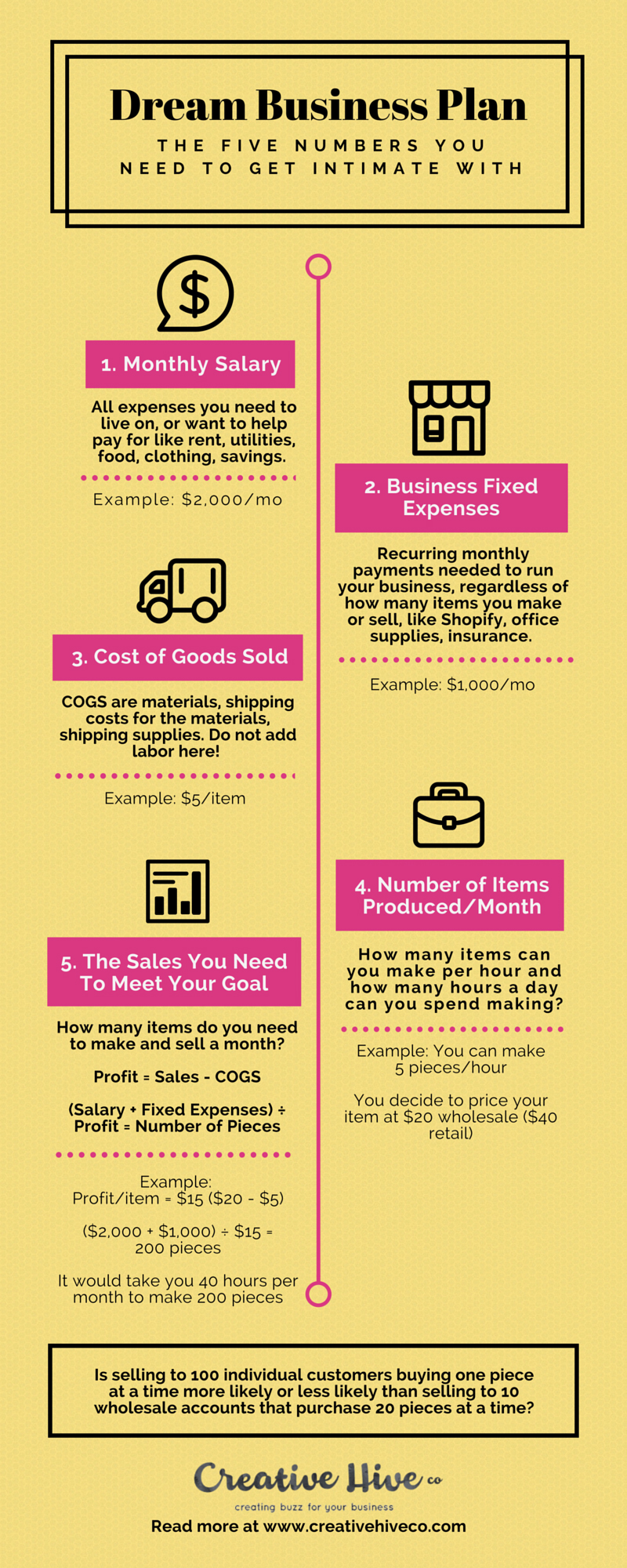Dream Business Plan: The Five Numbers You Need To Get Intimate With
I want to help you build a sustainable, profitable handmade business that makes you consistent income and sales. I only ever teach or recommend marketing, social media, pricing, production and branding tips that I’ve personally used successfully in my own 7-figure handmade businesses.
I'm Mei, from Los Angeles!
Read More
Popular Posts You'll Love
Looking for something?
Categories
starting a business
get more traffic
running a business
make more sales
branding
growing a business
mindset & productivity
podcasts
pricing & money
product photography
reviews
selling on etsy
selling on amazon
social media
selling wholesale
- Facebook9
- Twitter5
- Pinterest2.9K
- 2.9Kshares
You’ve got an Etsy shop, a website, you do craft shows or you do all three.
You think you’re doing okay.
I mean, you’re making stuff and it’s selling!
But how do you know if, when and how this can become your dream business?
We’ll be giving you a map that shows you how!
It’s like painting by numbers – you draw your own map with the help of magical formulas and numbers we’ll give you.
Don’t panic!
Formulas are your friends.
You enter numbers in them and they provide the answers to your burning business questions, like how do I price my things?
Simple! You use a pricing formula.
(Cost of materials + cost of labor) x 2 = Wholesale price
Wholesale price x 2 = Retail price
Here’s a secret about formulas that no one talks about:
If you leave anything out of your costs or under value your labor you may get results that aren’t ideal.
Garbage in, garbage out.
So let’s talk you through how to draw your own map!
Your Goal with Your Business
First, you need to figure out what your goal is.
This is what you want or expect this business to do for you.
It could be just to make a little extra cash on the side or it could be for it to become your full time career.
A goal is worthless if you don’t know the Five Numbers associated with it to make it a reality.
Here are the Five Numbers.
The 1st Number: Your Monthly “Salary”
Add up what you actually need to live on.
Include every necessary cost for living, like:
- savings
- loan payments
- taxes
- insurance
- rent/mortgage
- groceries
- cable
- phones
- clothing
- recreational activities
If you share a household, determine what your contribution has to be.
If you don’t really need (for your survival) to make anything from your business, determine what you want to make for:
- extra savings
- vacations
- a new car
- kids’ extra-curricular activities
- home improvement
The idea is to figure out what your “take home” from your craft biz needs to be for you to meet your financial obligations and/or your financial desires.
Make a simple spreadsheet that lists all those expenses and total it up.
You can use yearly totals and divide by 12 to get a monthly picture.
As an example, we’ll say you determined you need $2,000 a month to live on.
The 2nd Number: Your Business’ Fixed Expenses
Fixed Expenses are the expenses your business incurs to operate, like rent and utilities.
This is known as overhead.
You might be a home based business. In that case, some or all of the overhead is part of the household expenses listed in “Salary” above.
But you still have fixed business expenses like:
- Shopify monthly plan
- Shipping software recurring payment
- Social media automation tools
- Traveling and accommodation for your out of town shows
- Office supplies
- Insurance and licenses
- Professional fees if you use a CPA or attorney
If you have an expense you don’t know how to categorize, I recommend including a miscellaneous expense line for everything else.
It’s much better than not including it at all!
Use a simple spreadsheet to list all the expenses and total it up.
Stuff you pay yearly like insurance gets divided by 12.
You may also not buy office supplies each month, so use last year’s total divided by 12.
You can estimate if you haven’t been in business that long, but as soon as you have real data, you’ll need to revisit the total.
OK. DID IT, ARE WE THERE YET?
You’ve got two numbers now:
- What you need to live on; your “salary”: $2,000 per month
- Average monthly overhead: $1,000 per month
What does this mean?!
Your business must generate enough revenue to cover a total of $3,000 in total expenses.
Turns out you sold $3,000 worth of products last month.
Woohoo!
Hold on to your horses. Hold on to your calculators!
We just calculated Fixed Expenses. But you haven’t yet factored in your Variable Expenses.
Fixed Expenses are always the same every month regardless of how many pieces you made.
Expenses can be variable because these are directly tied to the number of pieces you make.
These expenses are also known in accounting lingo as your “cost of goods sold”.
The 3rd Number: Your Cost of Goods Sold
Variable Expenses or Cost of Goods Sold (or COGS) is the total of:
- material costs to make your product
- shipping supplies
Double check them and make sure you include shipping costs for materials you bought and any special boxes or packaging you use per piece.
You should factor in a small loss percentage to account for materials that go bad, pieces that aren’t sell-able, etc.
For the purpose of creating your Dream Business Plan, don’t include your labor here (unlike the pricing formula).
Here’s why.
You’ve established what you need to take home from your business for survival, your “salary”. That’s the first number you calculated!
And accounting programs treat wages and salaries as expenses and not part of the actual COGS.
You should total the cost of goods per each item you make.
But the number we want to look at right now is the total for all your sales per month.
If you have last years’ numbers, you can take a short cut and grab the total dollar amount spent on materials and packaging and divide by 12.
For simplicity’s sake, we’re going to assume you only make and sell one design.
This item’s COGS is $5.
Remember, this includes:
- materials and supplies used
- shipping to get your materials to you
- packaging
The 4th Number: The number of goods that you can produce monthly
This number depends on how you make your products.
The simplest formula is:
How many items you can make per hour x How many hours you can spend in production
The end result you want is the number of pieces that can reasonably produce, ready to sell, per month.
You figure you can make 5 pieces per hour.
You’ve priced it at $20 wholesale ($40 retail).
The 5th Number: The Sales You Need to Meet Your Goal
Sales – COGS = Profit
If you sell one piece wholesale, your profit is $15 (that’s a $20 sale minus $5 in COGS).
Divide $3,000 (your monthly total expenses) by $15 and you get 200 pieces
Let’s figure out the profit:
200 pieces x $20 wholesale price = $4,000 gross sales
$4,000 gross sales – $1,000 COGS (200 pieces x $5) = $3,000 profit
Can you make 200 pieces per month to get you the $4,000 gross sales?
5 pieces made/hour x 2 hours/day = 10 pieces/day
10 pieces/day x 20 work days/month = 200 pieces per month
Technically, yes.
Only you will know if such a production schedule works for you.
You can always increase the hours per day or the days per month you work in production.
Putting the Five Numbers Together
In this example, you now know how many pieces you have to sell per month to meet your financial needs.
And you have a picture of where you can make changes to make it happen.
For instance, we used wholesale prices above, but you’d only have to sell 100 pieces at retail.
Then you can ask yourself:
Is selling to 100 individual customers buying one piece at a time more likely or less likely than selling to 10 wholesale accounts that purchase 20 at a time?
Now you have an idea about where to focus your sales and marketing efforts.
Knowing these numbers, and changing them when things change (like your cost of goods go up, or your rent is raised), keeps you focused on your goal.
You want to look at your profits regularly and check to see if they’re covering business overhead and your salary (take home goals).
This is your first step to creating the financial map that keeps your business on track with your goals.
By the way, it’s also called a business plan.
You just made one! :)
 This post was written by Melissa Kaye Zeppa based in Perisburg, VA. For 25 years (that’s 175 in dog years!), Zeppa Studios has been designing and producing unique and whimsical animal themed giftware and accessories featuring original artwork by studio founder, M. K. Zeppa.
This post was written by Melissa Kaye Zeppa based in Perisburg, VA. For 25 years (that’s 175 in dog years!), Zeppa Studios has been designing and producing unique and whimsical animal themed giftware and accessories featuring original artwork by studio founder, M. K. Zeppa.
Math and numbers can be scary. Got questions? Leave them in the comments below.

Leave a Comment
Liked this article? Share it!
Unlock a Profitable Handmade Business
in Just 12 Weeks Without Using Etsy
or Social Media
FREE WORKSHOP
This workshop is for anyone who makes and sells a handmade or physical product, including jewelry designers, artists, paper designers, bath & body product makers and more!
What You'll Discover
The #1 mistake people make with Etsy & social media that causes shops to FLOP
The secret to making it with your handmade shop so it's no longer just a hobby
How to make sales in your handmade shop with ease so you can finally get to 6-figures
TAKE ME THERE
Your email address will not be published. Required fields are marked *
Leave a Reply Cancel reply
About
Blog
A Sale A Day
Student Login
Free Class
Contact
Terms
Become A Student
Watch On YouTube
Student Reviews
See My Handmade Shop!




I just wanted to thank you for the lovely, helpful breakdowns in this article of where costs and advocating for self expenses can benefit long-term, rather than getting “garbage in, garbage out.” I saw you had garbage comments, so wanted you to know this article is pretty darn great, actually! :)
I’m grateful to have come across this article. It’s a testament to the power of knowledge and action in shaping a brighter future for us all.
So great. Thank you for your help. That’s what I am looking for.
“Understanding key financial metrics is crucial for any business owner! Speaking of keeping track of numbers, have you tried the Slope game? It’s a free online game where you navigate a ball through a course while trying to achieve the highest score possible. It might be a fun way to engage with numbers in a more playful setting after diving into business planning.”
When crafting your dream business plan, it’s essential to understand and get intimate with five key numbers that can make or break your success. This topic is a top search trend because entrepreneurs and business owners are increasingly focusing on financial metrics to guide their strategic decisions. These critical numbers include cash flow, profit margins, break-even point, return on investment, and customer acquisition cost. Mastering these figures helps ensure that your business plan is robust, realistic, and geared towards achieving long-term success.
The “Dream Business Plan: The Five Numbers You Need to Get Intimate With” offers essential insights for building a successful business. Mastering these key metrics is like solving wordle unlimited, each number helps you piece together a clearer picture of your financial health, guiding you towards strategic decisions and success.
Here’s a formula tip: neglecting costs or undervaluing labor leads to subpar outcomes, as in the slope game . Let’s guide you in mapping out your business goals effectively!
This piece provides a fresh and compelling take on the subject.
Are you ready to elevate your handmade business and earn consistent income? I’m Mei from Los Angeles, and I share proven strategies for marketing, branding, and more. Just like mastering the Slope game requires practice and strategy to excel, building your business takes dedication and the right techniques. Discover how to turn your passion into profit with our tailored guidance. Let’s embark on this journey together!
Great insights on turning creative passions into profitable ventures! I love how you compare it to painting by numbers; it really demystifies the process. Just like in the Monkey Mart game, where strategic decisions lead to success, applying these formulas will allow you to gauge your earnings and pricing effectively. Can’t wait to see how others here interpret the “map” for their own businesses!
This article provides great insights and useful information for anyone interested in enhancing their gaming experience. If you’re a fan of arcade-style challenges, the Sprunki game offers exciting gameplay that keeps you engaged. It’s a perfect choice for both casual players and those looking to improve their skills. Don’t hesitate to share your thoughts and experiences with the Sprunki game to help others discover this fun title.
Navigating the world of small business can feel like traversing a labyrinth with no map in hand. For many, the promise of turning passion into profit remains tantalizing yet elusive. Pricing strategies can make or break your endeavor, much like my experience on Omegle, where finding the right conversation often hinges on knowing how to ask the right questions. Remember, without a clear understanding of your costs and goals, your dream business may remain just that— a dream.
It’s promising a roadmap to figure out the pricing puzzle and everything else that makes or breaks a creative business. I remember when I first started selling my pottery, I just guessed at prices. Total chaos! Speaking of chaos, that whole pricing situation felt like playing a level in geometry dash, completely blindfolded, with no power-ups!
I understand the struggle! Pricing creative work can indeed feel like navigating a chaotic situation, just like a frustrating level in Geometry Dash. It sounds like you need a solid plan to keep things stable. Consider playing monkey mart, a simulation GAME where you learn resource management and set the optimal prices. In monkey mart you can run your own store, but if you need a break, there’s always GAME Monkey Mart!